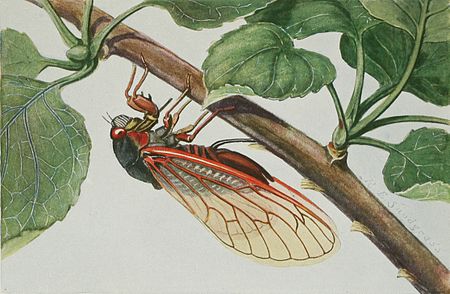Template:Species-2012-06-2
Species of the month
editDecim Periodical Cicada
editSome facts on this insect:
Body length: 28-29 mm.
Eggs deposited by the female: 400-600.
Male song: High-pitched call resembling "weeeee-whoa" or "Pharaoh".
Range: Canada and the United States.
Life-span: 17 years.
First described: By Swedish naturalist Carolus Linnaeus in 1758, who originally named it Cicada septendecim.
No insect has more patience than Magicicada septendecim. These cicadas spend 17 years underground, waiting for the proper time. Then, all of a sudden, the mature nymphs emerge synchronously in tremendous numbers. The adults are active for about 4 to 6 weeks, when the males aggregate into chorus centers and attract females for mating. The females puncture the bark of twigs using the blades of a sawlike device at the end of their abdomen and make a pocket in the wood, where they lay their eggs. Hatching occurs six to seven weeks after egg laying. The adults drop dead and the white, antlike nymphs work their way out of the slits and make it to the ground, burrow to about 3 cm beneath the soil surface and stop and await the right time to emerge again. The life cycle is complete, and the cicadas are gone for another 17 years. Magicicada septendecim are devided into broods designated by Roman numerals based on the year they emerge. The numerals I through XVII are assigned to the 17-year broods. For example brood I are called "The Blue Ridge Brood". They last emerged in 1995 and are expected to emerge again in 2012. The periodical cicadas include 7 species: three follow a 17-year cycle and four more species follow a 13-year cycle. They belong to the family Cicadidae which contains about 2,500 species around the world.
See also: Species of previous months
